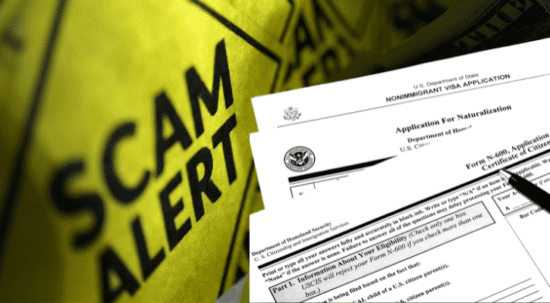Asylum processing is paused right now. USCIS is not making decisions on any new or pending asylum cases. This includes people of all nationalities while USCIS reviews security procedures. This pause applies to USCIS cases only and does not include defensive asylum cases in immigration court. You can still apply for asylum, but you will not get a decision on your case until the pause ends. Talk to an immigration lawyer.
What is asylum?
Asylum is a form of protection that allows you to stay in the USA if you have been persecuted or fear persecution in your home country because of your race, religion, nationality, membership in a particular social group, or political opinion.
When you are granted asylum, you can:
- Stay in the USA legally with protection from detention and deportation
- Ask for asylum for your spouse and children
- Automatically qualify for a work permit to work in the USA
- Apply for a Social Security card, travel documents, a Green Card, and citizenship
- Be eligible for resettlement services for a period of time, including financial and medical assistance, English classes, employment, and mental health services
Asylum requirements
You can seek asylum only if you:
- Fear persecution in your home country
- Are physically in the United States
- Arrived in the U.S. less than one year ago (with some exceptions)
- Have not already resettled in another country
- Have not committed certain crimes and are not considered a threat to U.S. safety or security
If you do not meet the above requirements, you may still be eligible for lesser forms of protection, such as Withholding of Removal and protection under the Convention Against Torture. Withholding of Removal can stop you from being deported if you show a judge that it is very likely you would be harmed or tortured in your home country because of your race, religion, nationality, political opinion, or social group. It is different from asylum because it does not lead to a Green Card, and you cannot include your family in your application.
Applying for asylum
You must apply for asylum within one year of arriving in the USA unless you meet an exception. There is a $100 fee to apply. You will also have to pay at least $100 for every year that your application is pending. The steps you take will be different depending on whether you are seeking affirmative asylum, defensive asylum, or have had a positive credible fear screening.
There are 2 ways to get asylum in the United States:
The affirmative process is for people who are not in deportation or removal proceedings. An asylum officer with U.S. Citizenship and Immigration Services (USCIS) reviews and decides affirmative cases.
Defensive asylum – Immigration Court
The defensive process is for people who are in deportation or removal proceedings before an immigration judge with the Executive Office for Immigration Review (EOIR). A judge reviews and decides on defensive cases.
You may be placed in removal proceedings if:
- U.S. Customs and Border Protection (CBP) claims you entered the USA without proper documents
- U.S. Immigration and Customs Enforcement (ICE) arrested you within the U.S. for not having legal status
- Your affirmative asylum was not approved
If your asylum case is not considered strong enough, you could be denied asylum without a final hearing.
The Asylum Seekers Advocacy Project (ASAP) is a helpful resource.
You need documents showing proof of your identity and nationality, a photograph, a written declaration, and country condition reports. You will need to provide certified translations of any documents that are not in English.
New policy directs courts not to accept an affirmative asylum application referred by USCIS unless it includes all required supporting documents. If anything is missing, your application could be rejected or delayed, so make sure to provide all necessary evidence upfront.
The new administration has made it very difficult for you to ask for asylum at the U.S.-Mexico border by closing official entry points to asylum seekers. Border officers can also send you back to Mexico immediately, without allowing you to apply for asylum. Learn more
You cannot seek asylum at the U.S.-Canada border if you passed through Canada first, unless you meet an exception. This is called the Safe Third Country rule. This rule requires you to apply for asylum in whichever country you arrive in first (the U.S. or Canada). Find more information about this rule.
In some cases, you might be able to apply after being in the U.S. for one year. If you missed the deadline, you must meet strict requirements:
- Changes in the conditions in your country of origin
- Activities you have become involved in that change your fear of persecution
- Previously been a dependent on someone else’s pending asylum application
- A serious illness or mental or physical disability interfered with your ability to apply within one year
- Legal disability, such as your status as an unaccompanied child, or if you have suffered from a mental impairment
- You were wrongly advised by your legal counsel
- Afghan parolees may qualify for an exception to the 1-year filing deadline

The asylum process is complex. Free and low-cost lawyers can help you complete your application and prepare for your interview or hearing. Review your options and get support.
Affirmative asylum process
You must be in the U.S. or at a port of entry to apply for asylum. A port of entry can be an airport, seaport, or border crossing. If you are not in removal proceedings, you can apply for affirmative asylum directly with U.S. Citizenship and Immigration Services (USCIS).
You need to fill out and submit Form I-589. Be sure to use the latest edition of the form, edition 01/20/2025. If you do not use the correct form, USCIS will not accept your application.
If you are filing a new asylum application to USCIS, you can apply online and pay the initial filing fee at the end of the application. If you are filing by mail, complete Form G-1450 and include the form in the same envelope.
As of October 30, 2025, asylum seekers do not have to pay the $100 yearly asylum fee. This is different from the initial filing fee. The pause is temporary because of a lawsuit, and you may need to pay soon if your case has been pending for more than a year.
You can list your husband, wife, or unmarried children under 21 as dependents on your application if they are in the United States. They will get the same decision in the asylum case as you.
They can also apply separately if they have been persecuted or fear persecution. An attorney can help you decide which is best. Children over the age of 21 or married children must file their asylum applications separately.
- An asylum officer with USCIS will review your application and send you a receipt notice.
- There are currently delays in issuing receipts. For purposes of the one-year filing deadline, affirmative asylum interview scheduling priorities, and Employment Authorization Document eligibility, your filing date will still be the date USCIS received your Form I-589.
- You will receive a fingerprinting appointment notice from your local Application Support Center (ASC).
- You will receive a notice scheduling you for an interview with an asylum officer at the closest USCIS office.
- If your application is still pending after a year, you will need to pay the fee.
You can check the status of your application online by typing in your receipt number.
You may ask USCIS to expedite your asylum interview to process it faster if you meet certain requirements, such as serious financial harm.
USCIS is interviewing new applicants first and working back towards the list of older filings. The scheduling order is:
- Applicants who were originally scheduled for an interview but had to be rescheduled for certain reasons.
- Applications that have been pending for 21 days or less.
- All other pending affirmative asylum applications start with newer filings and work back toward older filings.
An asylum officer will review your asylum application and ask you questions about your fear of returning to your home country. A lawyer can help you prepare and be at your interview. Learn what to expect at the affirmative asylum interview.
If you need language support, you must bring an interpreter to your asylum interview. Your interpreter must be 18 years or older. Your interpreter must be fluent in English and your language. Your interpreter cannot have a pending asylum case. Your attorney or accredited representative, witness, and anyone involved in your case cannot serve as your interpreter.
The law guides USCIS to make a decision on asylum cases within 180 days of receiving applications. While new EOIR guidance is enforcing this rule more strictly, the current backlog may still cause delays. Many asylum cases are waiting to be processed.
USCIS will let you know when you can pick up your decision at the asylum office that interviewed you. USCIS may mail your decision to your home if it takes longer to process your claim.
While you wait for a decision, you should:
- Apply for a work permit. If you are a pending asylum seeker, you must wait 150 days before applying.
- Avoid traveling outside the U.S. except for emergencies. If you must leave the country, you will need to file Form I-131 with USCIS to re-enter the USA. You may not be allowed back into the country.
If you received a letter from USCIS saying your case was dismissed, talk to an immigration lawyer.
Yes. If you are denied asylum, you can ask for a judge to review your decision given by the asylum officer. This will put you in defensive asylum processing before the immigration court. An immigration judge will review your case and give a new decision.
Defensive asylum process
If you are in a U.S. immigration detention center or removal proceedings, you can apply for defensive asylum with an immigration judge. If you do not have an asylum application already on file, you must fill out and submit Form I-589.
If your Form I-589 is incomplete or missing the required documents, it will not be accepted. You must answer every question, sign the form correctly, and submit all required materials for it to be processed.
Your case will be a defensive asylum if you:
- are placed in removal proceedings after USCIS did not grant you affirmative asylum
- were subject to expedited removal, found to have a credible fear, and were issued a Notice to Appear
- are placed in removal proceedings by ICE or CBP for immigration violations
The asylum process is very complicated. It is important to review your options for legal help.
If you are filing a new asylum application to immigration court, pay the $100 initial filing fee on this EOIR website and include a receipt showing you paid the fee in your application.
As of October 30, 2025, asylum seekers do not have to pay the $100 yearly asylum fee. This is different from the initial filing fee. This pause is temporary because of a lawsuit, and you may need to pay soon if your case has been pending for more than a year.
- An immigration judge with EOIR will review your application and send you a receipt notice.
- You will receive a fingerprinting appointment notice with your local Application Support Center (ASC).
- You will receive a hearing notice with an immigration judge to present your asylum claim.
You can check the status of your court case online or by calling the EOIR hotline at 1-800-898-7180.
- Be sure to go to all of your appointments with ICE and your court hearings with EOIR.
- If you move, send a change of address form to ICE and EOIR within 5 days of moving.
- Carry copies of your paperwork to show you have an asylum application in progress in case ICE stops you.
The hearing is when a judge listens to your story. Your lawyer and the ICE lawyer will ask you questions. You may also have witnesses speak on your behalf.
You will be provided an interpreter if you are not fluent in English.
The law guides EOIR to make a decision on asylum cases within 180 days of receiving applications. While new EOIR guidance is enforcing this rule more strictly, the current backlog may still cause delays. Many asylum cases are waiting to be processed.
The immigration judge will likely give their decision at the end of your final hearing. The immigration judge may choose to mail you a written decision shortly after your final hearing.
Yes. You can appeal the decision of the immigration judge to a higher court called the Board of Immigration Appeals (BIA). You must file Form EOIR-26, a Notice of Appeal, within 30 days of the date of your decision. An immigration attorney or accredited representative can help you with this.

Learn how to prepare for court hearings if you are facing deportation.
Next steps after being granted asylum
- Get help with resettlement services.
- Apply for a Social Security card.
- Get a driver’s license or state identification card.
- Find a job. You can work without having to apply for a work permit or EAD.
- Travel outside the U.S. You must first apply for a travel permit.
- Ask to bring your spouse and unmarried children under 21 years to the U.S. through family reunification.
- Apply for a Green Card one year after receiving asylum.
- Apply for citizenship 4 years after receiving a Green Card.
USAHello से और
क्या आपको कोई जानकारी चाहिए?
इस पेज पर जानकारी DHS, USCIS, और अन्य भरोसेमंद स्रोतों से आती है. हमारा उद्देश्य है कि हम आसानी से समझ में आने वाली जानकारी प्रदान करें, जिसे नियमित रूप से अपडेट किया जाता रहे. यह जानकारी कानूनी सलाह नहीं है.





